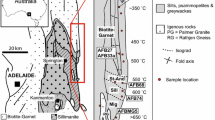Abstract
The fission track technique was used not only to determine the U distribution, but indirectly, to locate the host minerals of other incompatible elements such as P, Ti, Y, Zr and Nb in spilitic pillow lavas from SW England. The majority of U was introduced early in the alteration process probably due to interaction with sea-water. At a later stage in the process, these elements, some previously considered to be relatively immobile during low-grade alteration, were mobilised and subsequently redeposited in stable secondary phases. The hydrothermal fluid responsible for mobility was rich in CO2 and H2O. Carbonate complexes were the most likely mobile species.
Similar content being viewed by others
References
Aumento F (1971) Uranium content of mid-oceanic basalts. Earth Planet Sci Lett 11:90–94
Cann JR (1970) Rb, Sr, Y, Zr, Nb in some ocean floor basaltic rocks. Earth Planet Sci Lett 10:7–11
Duffield J, Gilmore GR (1979) An optimum method for the determination of rare earth elements by neutron activation analysis. J Radioanal Chem 48:135–145
Fleischer RL, Price PB, Walker RM (1975) Nuclear tracks in solids: principles and applications. Univ California Press
Floyd PA (1977) Rare earth element mobility and geochemical characterisation of spilitic rocks. Nature (London) 269:134–137
Floyd PA (in press) The Hercynian trough: Devonian and Carboniferous rocks in SW Britain. In: Sutherland D (ed) Igneous rocks of the British Isles
Floyd PA, Rowbotham G (1979) Chemical composition of relict clinopyroxenes from the Mullion Island lavas, Cornwall. Proc Ussher Soc 4:419–429
Floyd PA, Tarney J (1979) First-order alteration chemistry of Leg 49 basement rocks. In: Luyendyk BP, Cann JR (eds). Initial Reports, DSDP 49. Washington, US Govt Printing Office, pp 693–708
Floyd PA, Winchester JA (1975) Magma type and tectonic setting discrimination using immobile elements. Earth Planet Sci Lett 27:211–218
Frey FA, Bryan WB, Thompson G (1974) Atlantic ocean floor: geochemistry and petrology of basalts from Legs 2 and 3 of the Deep Sea Drilling Project. J Geophys Res 79:5507–5527
Frondel JW (1975) Lunar Mineralogy. Wiley-Interscience, New York
Hellman PL, Henderson P (1977) Are rare earths mobile during spilitization? Nature (London) 267:38–40
Hellman PL, Smith RE, Henderson P (1977) Rare earth element investigation of the Cliefden outcrop, NSW Australia. Contrib Mineral Petrol 65:155–164
Herrmann AG, Potts MJ, Knake D (1974) Geochemistry of the rare earth elements in spilites from the oceanic and continental crust. Contrib Mineral Petrol 44:1–16
Humphris SE, Morrison MA, Thompson RN (1978) Influence of rock crystallization history upon subsequent lanthanide mobility during hydrothermal alteration of basalts. Chem Geol 23:125–137
Hynes A (1980) Carbonitization and mobility of Ti, Y and Zr in Ascot Formation metabasalts, SE Quebec. Contrib Mineral Petrol 75:79–87
Kleeman JD, Lovering JF (1967) Uranium distribution studies by fission track registration in Lexan plastic prints. At Energy in Australia 10:3–8
MacDougall JD (1977) Uranium in basalts: concentration, distribution and implications. Earth Planet Sci Lett 35:65–70
MacDougall JD, Finkel RC, Carlson J, Krishnaswami S (1979) Isotopic evidence for uranium exchange during low temperature alteration of oceanic basalts. Earth Planet Sci Lett 42:27–34
McLennan SM, Taylor SR (1979) Rare earth element mobility associated with uranium mineralization. Nature (London) 282:247–250
Menzies M, Seyfried W, Blanchard D (1979) Experimental evidence of rare earth element immobility in greenstones. Nature (London) 282:398–399
Mitchell WS, Aumento F (1977) Uranium in oceanic rocks: DSDP Leg 37. Can J Earth Sci 14:794–808
Mory J, De Guillebon D, Delsarte G (1970) Mesure du parcours moyen des fragments de fission avec le mica comme detecteur influence de la texture crystalline. Rad Effects 5:37–40
Pearce JA (1975) Basalt geochemistry used to investigate past tectonic environments on Cyprus. Tectonophysics 25:41–68
Pearce JA, Cann JR (1973) Tectonic setting of basic volcanic rocks determined using trace element analyses. Earth Planet Sci Lett 19:290–300
Pearce JA, Norry MJ (1979) Petrogenetic implications of Ti, Zr, Y and Nb variations in volcanic rocks. Contrib Mineral Petrol 69:33–47
Rankin AH, Alderton DHM, Thompson M, Goulte (in press) Determination of uranium: carbon ratios in fluid inclusion decrepitates by inductively-coupled plasma emission spectroscopy. Mineral Mag 76
Read JI (1972) A non-aqueous titrimetric determination of acidevolved carbon dioxide in silicate rocks. Analyst 97:134–137
Shapiro L, Brannock WW (1955) Rapid determination of water in silicate rocks. Anal Chem 27:560–564
Smith RE, Smith SE (1976) Comments on the use of Ti, Zr, Y, Sr, K, P and Nb in classification of basaltic magmas. Earth Planet Sci Lett 32:114–120
Storzer D, Selo M (1980) Fission track age of magnetic anomaly M-Zero and some aspects of sea-water weathering. In: Donnelly T et al. (eds). Initial Reports of the Deep Sea Drilling Project 51, 52, 53, Part 2. Washington, US Govt Printing Office, pp 1129–1133
Vallance TG (1974) Spilitic degradation of a tholeiitic basalt. J Petrol 15:79–96
Williams CT (1978) Uranium-enriched minerals in mesostasis areas of the Rhum layered pluton. Contrib Mineral Petrol 66:29–39
Wilson IR, Floyd PA (1974) Distribution of uranium in the Land's End granite and aureole, and various greenstones from Cornwall. Proc Ussher Soc 3:166–176
Author information
Authors and Affiliations
Rights and permissions
About this article
Cite this article
Williams, C.T., Floyd, P.A. The localised distribution of U and other incompatible elements in spilitic pillow lavas. Contr. Mineral. and Petrol. 78, 111–117 (1981). https://doi.org/10.1007/BF00373772
Received:
Accepted:
Issue Date:
DOI: https://doi.org/10.1007/BF00373772




